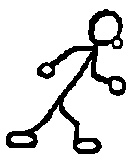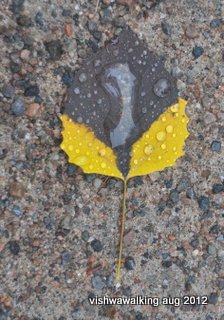About Us
Vishwawalking explained
 Ratings Explained
Ratings ExplainedVishwawalks
Day walks
Funky Places
Future walks
Gear
Food
Right to Ramble
Good reads
Site map
Links
Contact us

Fawn in a roadside ditch
June 5, 2005
Vishwawalking Explained (sort of)
If you wish to see a country well, you must traverse it in other directions than those whither the high roads lead you.
— Charles
Boner, Guide
for Travellers, In the Plain and On the Mountain, (1876)
Field, east side of County Road #23, Prince Edward County, Ontario.
July, 2008

Walking around the world
| On
January 17,
2005, I wrote in my walking notebook: "The world's circumference is 40,076 kilometres (24,902 miles) at the equator. "Today I decided to walk around the world. Not all at once. I will start my walking tour around the world on February 3, 2005, when I turn 55. Considering I will want to stop often to meet people and I don't want to take the shortest route, this project could take some time. With all the ups and downs and 'round abouts, I could hike over 40,000 kilometres. That means I'd have to walk at least 1,000 kilometres per year to complete the walk when I am 94. "This will take some dedication. I should buy a good pair of walking shoes." Well, I did rack up a lot of miles. I was attempting to write my dissertation for my PhD at the time, and walking was a fine distraction. I never did finish the PhD. I stopped vishwawalking for a couple of years out of guilt. I still walked, but did not take notes. After I walked the Camino de Santiago in 2015 I kept walking, but I stopped the formal vishwawalking process of walking in a continuous thread and of making detailed notes. As many have done before me, perhaps I will have to do some conceptual walking. If I walk around the country roads around my home and map a parallel number of kilometres through China (say) perhaps that will have to do. Or live to 99 and get more rigorous in my walking schedule and my recording practices. Or not. |
The Rules1. In general, any kind of walking for
walking’s sake is vishwawalking. A stroll around a garden or around the
block
can be vishwawalking. 2. The following rules for vishwawalking are
for those who want a more
directed goal and a challenge. However, vishwawalking is not a contest.
Anyone wanting to vishwawalk can set whatever
goal they like. Or no goal. 8. A walker can walk as short a distance
as she/he likes in the process of building a thread. A .5-kilometre
walk is just fine. If the walk is part of a thread, then the walk
can be
taken up from where the walker left off. If threads are neglected for
days,
weeks or years, it is not a problem as long as the walker keeps a record of where they left off. 10. Bodies of water. If a river is encountered it can be crossed, preferably by walking (over ice), swimming, paddling, rowing or sailing. However, motoring across, if that is the only logical alternative, is acceptable. Most lakes should be walked around (even most large ones) if they can't be walked across. 11. Oceans must obviously be crossed.
However, threads can continue across oceans. I can continue a thread
(say)
through Nova Scotia to the ferry port, cross to Newfoundland, walk to
the
easternmost point in Newfoundland, fly to Ireland, then continue from
(say) the
most western point of Ireland, or wherever the closest large land mass
might be
in the direction I am heading. All of this can be one thread.
12. Any walker who paddles or sails an ocean as part of a thread gets a heap of respect from fellow vishwawalkers. |
19. This rule just took a walk around the block, and so is absent. |

Leaf on the logging road to McKaskill ranger cabin
Algonquin Park, Ontario Canada
August 8, 2012
Page
created: February 3, 2009
Updated: October 24, 2021
Updated: October 24, 2021